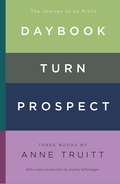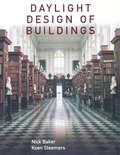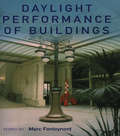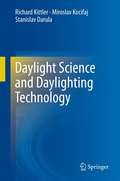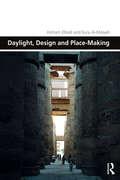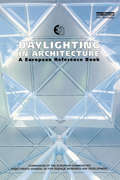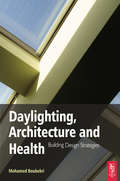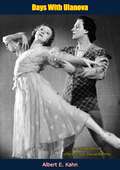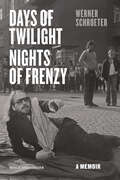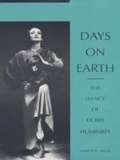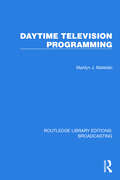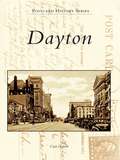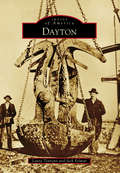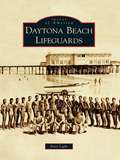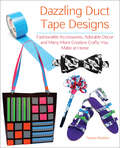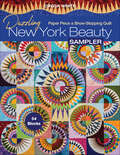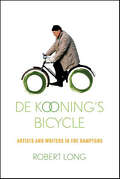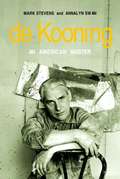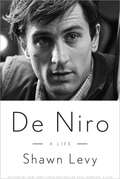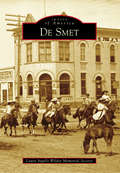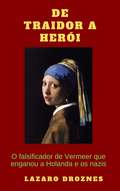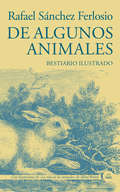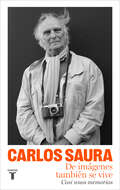- Table View
- List View
Daybook, Turn, Prospect
by Audrey Niffenegger Anne TruittAll three of Anne Truitt's artist's journals in one e-volume, the illuminating, inspiring record of a woman's reconciliation of the call of creative work with the demands of daily life--with a new introduction by Audrey Niffenegger.Anne Truitt kept a journal throughout her adult life, from her early years as one of the rare, celebrated women artists in the early 60s, through her midlife as an established artist, and into older age when she was, for a time, the director of Yaddo, the premier artists' retreat in Saratoga. She was always a deep, astute reader, and a woman who grappled with a range of issues--moral, intellectual, sensual, emotional, and spiritual. While working intensely on her art, she watches her own daughters journey into marriage and motherhood, meditates on criticism and solitude, and struggles to find a balance in life. "Balance not stability is the source of security," she says. Anne Truitt re-creates a life in which domestic activities and the needs of children and friends are constantly juxtaposed against the world of color and abstract geometry to which she is drawn in her art.
Daylight Design of Buildings: A Handbook for Architects and Engineers
by Nick Baker Koen SteemersTo complement the critical and objective view gleaned from the study of some sixty buildings, this design manual has been developed to provide a more synthetic approach to the principles which lie behind successful daylight design. These principles are illustrated with examples drawn from the case study buildings. The emphasis throughout has been on practical methods to improve design, rather than techniques studied for any intrinsic interest. The book provides the necessary tools to assist the designer to provide well daylit interiors, and shows that good daylight design is not a restriction on architectural expression but, on the contrary, acts as an inspiration and foundation for good architecture.
Daylight Performance of Buildings
by Marc FontoynontAs part of Daylight Europe, the daylighting behaviour of 60 buildings was observed and measured during a three year period. Buildings of many different types, sizes and ages were included - from offices to museums, libraries, churches, houses, airports and factories; from Classical buildings to modern constructions, and from a small single room to an office of over 100,000 square meters. The results of the study of each building are presented, extensively illustrated in colour, with the unusual features and main lessons highlighted. The book also includes details of the monitoring procedures, the results of and comparisons with simulations, the outcome of post-occupancy evaluation, and a summary of the major findings. These show the extraordinary potential of daylighting techniques to improve amenity and energy performance for the benefit of the occupants and building managers. They also demonstrate how often opportunities are missed, and the frequency of problems of overheating or glare. Above all, they demonstrate the beauty, elegance and scope of daylight design.
Daylight Science and Daylighting Technology
by Miroslav Kocifaj Richard Kittler Stanislav DarulaSunlight profoundly influences the Earth's atmosphere and biosphere. Nature fuels the evolution of all living things, their visual systems, and the manner in which they adapt, accommodate, and habituate. Sun luminance measurements serve as data to calculate typical changes in the daily, monthly, and annual variability characteristics of daylight. Climate-based sky luminance patterns are used as models in predicting daylighting calculation and computer programs applied in architecture and building design. Historically, daylight science and daylighting technology has prioritized photometric methods of measurements, calculation, and graphical tools aimed at predicting or evaluating the daylighting of architectural design alternatives. However, due to a heightened awareness of general health and well-being, sunlight exposure and freedom from visual discomfort while undertaking visual tasks are now equally prioritized. Therefore, in order to assure optimal environmental quality, daylighting technology must be based on sound science. Daylight Science and Daylighting Technology, by Richard Kittler, Miroslav Kocifaj, and Stanislav Darula, sketches the entire evolution of daylight science from atmospheric science through apt visual workplace psychophysics.
Daylight, Design and Place-Making (Design and the Built Environment)
by Hisham Elkadi Sura Al-MaiyahDaylight, Design and Place-Making examines the role of daylight in creating and revealing the wonders of heritage and contemporary architecture. Shifting from a purely technical approach to daylighting, this book places importance on the creation of meaningful aesthetics through an understanding of context and culture. Cultural applications of light in architecture differ depending on various historical, technological, and social characteristics. Increasingly, there is a revival of interest in contemporary architecture using daylight as an essential contextual ingredient in the design process. By examining the architecture of daylight in different locales and setting these in their historical contexts, the book argues that appropriate use of daylight will ensure not only visual and thermal comfort in the urban setting and aid in energy efficiency, but also will contribute to the overall identity of new buildings, particularly in urban regeneration projects. This book brings together an analysis of technical aspects of daylight performance and environmental impact, with discussions on the psychology of daylighting and its influence in shaping perceptions of our built environment. It will be an ideal read for academics and researchers interested in architecture and cultural studies.
Daylighting and Integrated Lighting Design (PocketArchitecture)
by Christopher Meek Kevin Van WymelenbergDaylighting and Integrated Lighting Design provides architects, building designers, and students clear direction for the successful inclusion of daylight and integrated electric light in buildings. It presents design teams with the performance analysis resources, energy saving estimates and user satisfaction results they need in order to make informed decisions regarding daylighting and lighting design. Written by two well-known experts in the field, the book provides: critical geometric and material relationships along with proven design process activities, offered in a quick-reference format, with sufficient context to address the range of associated issues present in any building project both the "fundamentals" and "applications" which cover design concepts and practice activities applicable to all integrated lighting projects specific directives for how the concepts covered are applied in a range of common design scenarios, including architectural rules-of-thumb, instructions for ensuring visual comfort, and preferred approaches for electric lighting control integration. In demonstrating these necessary insights to designers, the authors employ an iterative analysis of common "daylighting patterns" and illustrate and annotate both successful and unsuccessful examples via built form and simulation. Part of the PocketArchitecture series, this is the ideal pocketbook for any designer serious about reducing the energy impact of their buildings.
Daylighting in Architecture: A European Reference Book
by Nick V. Baker A. Fanchiotti K. SteemersTypically one third of the energy used in many buildings may be consumed by electric lighting. Good daylighting design can reduce electricity consumption for lighting and improve standards of visual comfort, health and amenity for the occupants.As the only comprehensive text on the subject written in the last decade, the book will be welcomed by all architects and building services engineers interested in good daylighting design. The book is based on the work of 25 experts from all parts of Europe who have collected, evaluated and developed the material under the auspices of the European Commission's Solar Energy and Energy Conservation R&D Programmes.
Daylighting, Architecture and Health
by Mohamed BoubekriDaylighting, Architecture and Health examines the relationship between natural light in buildings and human health, considering both psychological and physiological issues and bringing together a range of research in the field. As we are becoming increasingly conscious of global warming and pushing towards energy efficiency in buildings, the book examines the question of daylighting from the perspective of the health of building occupants. It gathers and reviews all the latest and pertinent medical and architectural research related to natural light, or lack thereof, and its effect on people.* Documents medical research findings which establish a link between light quality and health* Considers design strategies for increasing daylight in buildings* Develops understanding and awareness of the importance of natural light in buildingsDaylighting, Architecture and Health: Building Design Strategies is a timely and essential text for professional architects and all others concerned with the effects of daylighting on health, architecture and building design.
Daylighting: Architecture and Lighting Design
by Michael Wilson Peter TregenzaThis authoritative and multi-disciplinary book provides architects, lighting specialists, and anyone else working daylight into design, with all the tools needed to incorporate this most fundamental element of architecture. It includes: an overview of current practice of daylighting in architecture and urban planning a review of recent research on daylighting and what this means to the practitioner a global vision of architectural lighting which is linked to the climates of the world and which integrates view, sunlight, diffuse skylight and electric lighting up-to-date tools for design in practice delivery of information in a variety of ways for interdisciplinary readers: graphics, mathematics, text, photographs and in-depth illustrations a clear structure: eleven chapters covering different aspects of lighting, a set of worksheets giving step-by-step examples of calculations and design procedures for use in practice, and a collection of algorithms and equations for reference by specialists and software designers. This book should trigger creative thought. It recognizes that good lighting design needs both knowledge and imagination.
Days With Ulanova: An Intimate Portrait of the Legendary Russian Ballerina (Dance Ser.)
by Albert KahnIn the great world of dance, Galina Ulanova is considered by many to be as great, if not greater, than Pavlova. Onstage, the miracle of her performances has enraptured vast audiences. But offstage, to the millions of her devotees, she remains an enigma. This exceptional biography—one of a kind—explores the world of Ulanova, and offers a unique look at the woman behind the legend.As a result of his friendship with Ulanova, writer-photographer Albert E. Kahn had the singular opportunity to study Ulanova as dancer, teacher, performer, warm friend, and a shy, modest woman seeking solitude among her beloved birch groves in the Russian countryside. Kahn has captured it all in words and pictures—from the magnificent performances to the intimate glimpses of her day-to-day life.“Days with Ulanova is the most exciting ballet book I have ever seen.”—Anatole Chujoy, Editor of The Dance Encyclopedia“All lovers of the dance, as well as libraries, museums and schools, will welcome this treasure of a book.”—Arthur Todd, New York Times“Mr. Kahn’s work is without precedent in the theatre world. His photographs of Ulanova are undoubtedly the finest imaginary job of visual commentary on any dancer.”—Genevieve Oswald, Curator Dance Collection, Library & Museum of Performing Arts, Lincoln Center“The particular treasure of her life has been lovingly and sensitively apprehended. Mr. Kahn has made us all a wonderfully valuable gift.”—Dance Magazine“This book must rank among the half-dozen most beautiful books on ballet ever published…a monument and a memorial.”—P. W. Manchester, Dance News
Days of Twilight, Nights of Frenzy: A Memoir
by Anthea Bell Claudia Lenssen Werner SchroeterWerner Schroeter was a leading figure of New German Cinema. In more than forty films made between 1967 and 2008, including features, documentaries, and shorts, he ignored conventional narrative, creating instead dense, evocative collages of image and sound. For years, his work was eclipsed by contemporaries such as Wim Wenders, Rainer Werner Fassbinder, Werner Herzog, and Alexander Kluge. Yet his work has become known to a wider audience through several recent retrospectives, including at the Museum of Modern Art, New York. Written in the last years of his life, Days of Twilight, Nights of Frenzy sees Schroeter looking back at his life with the help of film critic and friend Claudia Lenssen. Born in 1945, Schroeter grew up near Heidelberg and spent just a few weeks in film school before leaving to create his earliest works. Over the years, he would work with acclaimed artists, including Marianne Hopps, Isabelle Huppert, Candy Darling, and Christine Kaufmann. In the 1970s, Schroeter also embarked on prolific parallel careers in theater and opera, where he worked in close collaboration with the legendary diva Maria Callas. His childhood; his travels in Italy, France, and Latin America; his coming out and subsequent life as an gay man in Europe; and his run-ins with Hollywood are but a few of the subjects Schroeter recalls with insights and characteristic understated humor. A sharp, lively, even funny memoir, Days of Twilight, Nights of Frenzy captures Schroeter’s extravagant life vividly over a vast prolific career, including many stories that might have been lost were it not for this book. It is sure to fascinate cinephiles and anyone interested in the culture around film and the arts.
Days on Earth: The Dance of Doris Humphrey
by Marcia B. SiegelNow available in paperback, Days on Earth--originally published in 1988 (Yale University Press)--traces the dance career and artistic development of one of the founders of American modern dance. In this biography of dance pioneer Doris Humphrey, Marcia B. Siegel follows Humphrey's career from her days with the Denishawn Company (among fellos students like Martha Graham) to her creative partnership with Charles Weidman to her tenure as artistic director of protégé José Limon's dance company. Siegel's reconsideration and description of Humphrey's dances, including many that are no longer performed, sheds important light on this pathbreaking dancer/choreographer.
Daytime Television Programming (Routledge Library Editions: Broadcasting #19)
by Marilyn J. MatelskiDaytime Television Programming (1991) provides a practical understanding of daytime television formats, viewer demographics, and programming strategy. It compares daytime genres to their evening counterparts, discusses the effects of demographics on daytime programming, analyses investment yields, and highlights audience expectations. Discussions of specific daytime shows teach techniques necessary to overcome the enormous creative challenges in building a successful daytime lineup.
Dayton
by Curt DaltonThe rise and near destruction of Dayton in the early 20th century is chronicled in this visual postcard history. The postcards showcase some of the city's unique commercial buildings, hotels, churches, and residences, many now long gone due to urban renewal and highway construction in the 1960s and 1970s. Landmarks featured include the National Soldiers' Home, built for veterans of the Civil War in 1868, and there is an entire chapter dedicated to the events of the 1913 flood that forever changed the face of the city. Over 200 postcard images were selected from the Dayton Metro Library and a number of privately held collections.
Dayton (Images of America)
by Jack Folmar Laura TennantDayton's history begins with Nevada's first gold discovery in July 1849. It started with a California-bound pack train, led by trail guide Abner Blackburn, setting up camp at the mouth of a canyon that drained into the Carson River. While waiting for the snow to melt in the Sierra, Blackburn went prospecting and dug gold from the creek bed. The news of his discovery spread, and prospectors rushed to the site they called Gold Cañon--today's Dayton. In May 1851, diarist Lucena Pfuffer Parsons, traveling with a wagon train, camped at the site and reported about 200 miners living in the canyon. She noted that they were finding enough gold to trade for supplies. In 1859, after working their way up the canyon, miners discovered a large silver and gold deposit known as the Comstock Lode. This discovery led Nevada to statehood in 1864.
Daytona Beach Lifeguards (Images of America)
by Patti LightOn May 22, 1931, the American National Red Cross issued its second charter for a life preserving organization to the Daytona Beach Red Cross Life Saving Corps. Composed of 30 young men aged 17 to 26 and trained in lifesaving and first aid, this volunteer corps protected 3 miles of beach, compiling daily records of the number of bathers, weather, first aid, and rescues. The neighboring communities of Ormond Beach and New Smyrna Beach maintained their own lifesaving units, and Volusia County monitored the remaining coastline. By 1972, these four corps had united, and the Volusia County Beach Patrol became one of the nation's most highly trained surf lifesaving rescue units. Protecting 47 continuous miles of Atlantic coastline, which holds the dubious honor of the shark bite capital of the world, the Volusia County Beach Patrol welcomes 10 million visitors and performs an average of 3,000 rescues annually.
Dazzling Duct Tape Designs: Fashionable Accessories, Adorable Décor, and Many More Creative Crafts You Make At Home
by Tamara BoykinsCrazy cute creations made with colorful duct tape—it’s not just for repairs anymore! With eye-popping colors and exciting designs, duct tape is the most versatile and fun crafting material around. Just fold, cut and stick to make the amazing projects in this book, including:• bracelets • headbands • sandals • throw pillows • party banners • belts • purses • lunch bags • flower pens • reversible placemats • cellphone case * and moreIn addition to the decorative and useful crafts made with duct tape and just a few simple tools, you’ll even find a half dozen creative uses for your empty rolls!
Dazzling New York Beauty Sampler: Paper Piece a Show-Stopping Quilt; 54 Blocks
by Cinzia WhiteMake this extraordinary queen-size bed quilt inspired by Australian wildlife! Inspired by animals from kangaroos and koalas to bandicoots and emus, the fifty-four colorful blocks of this quilt from award-winning Australia-based designer Cinzia White join to form a breathtaking work of art. With its radiant beams and calculated curves, the New York Beauty quilt has always been a showstopper, and now you can paper-piece New York Beauty blocks inspired by Australian wildlife and make your own jaw-dropping Australian wedding quilt with Cinzia, the esteemed designer behind the Storyteller&’s Sampler Quilt. Don&’t be afraid to begin your foundation paper piece journey, as the author&’s clear instructions will guide you and help you feel truly accomplished. *Sew the New York Beauty quilt of your dreams *Stitch fifty-four unique blocks that pay homage to Australian wildlife *Learn to foundation piece a queen-size quilt by machine
De Kooning's Bicycle: Artists and Writers in the Hamptons
by Robert LongSome of the twentieth century's most important artists and writers--from Jackson Pollock to Saul Steinberg, Frank O'Hara to Jean Stafford--lived and worked on the East End of Long Island years before it assumed an alternate identity as the Hamptons. The home they made there, and its effect on their work, is the subject of these searching, lyrical vignettes by the critic and poet Robert Long.Pollock moved to Springs because he thought he wanted to stop drinking, but he found a connection to nature there that inspired some of the most significant paintings of our time. Others followed him. When Fairfield Porter bought a house in Southampton, the New York School suddenly had a new headquarters, and James Schuyler and Frank O'Hara found companionship and raw material for their poems on South Main Street and on the three-hour train ride between the city and the East End. Willem de Kooning rode his bike every day between his studio in the East Hampton woods and the bay, where the light informed every brushstroke he put to canvas from the early 1960s on. In De Kooning's Bicycle, Long mixes storytelling with history to re-create the lives and events that shaped American art and literature as we know it today, in a landscape where town met country and the modern met America's rural past.
De Kooning: An American Master
by Mark Stevens Annalyn SwanWillem de Kooning is one of the most important artists of the twentieth century, a true “painter’s painter” whose protean work continues to inspire many artists. In the thirties and forties, along with Arshile Gorky and Jackson Pollock, he became a key figure in the revolutionary American movement of abstract expressionism. Of all the painters in that group, he worked the longest and was the most prolific, creating powerful, startling images well into the 1980s. The first major biography of de Kooning captures both the life and work of this complex, romantic figure in American culture. Ten years in the making, and based on previously unseen letters and documents as well as on hundreds of interviews, this is a fresh, richly detailed, and masterful portrait. The young de Kooning overcame an unstable, impoverished, and often violent early family life to enter the Academie in Rotterdam, where he learned both classic art and guild techniques. Arriving in New York as a stowaway from Holland in 1926, he underwent a long struggle to become a painter and an American, developing a passionate friendship with his fellow immigrant Arshile Gorky, who was both a mentor and an inspiration. During the Depression, de Kooning emerged as a central figure in the bohemian world of downtown New York, surviving by doing commercial work and painting murals for the WPA. His first show at the Egan Gallery in 1948 was a revelation. Soon, the critics Harold Rosenberg and Thomas Hess were championing his work, and de Kooning took his place as the charismatic leader of the New York school—just as American art began to dominate the international scene.<P><P> Dashingly handsome and treated like a movie star on the streets of downtown New York, de Kooning had a tumultuous marriage to Elaine de Kooning, herself a fascinating character of the period. At the height of his fame, he spent his days painting powerful abstractions and intense, disturbing pictures of the female figure—and his nights living on the edge, drinking, womanizing, and talking at the Cedar bar with such friends as Franz Kline and Frank O’Hara. By the 1960s, exhausted by the feverish art world, he retreated to the Springs on Long Island, where he painted an extraordinary series of lush pastorals. In the 1980s, as he slowly declined into what was almost certainly Alzheimer’s, he created a vast body of haunting and ethereal late work.<P> This is an authoritative and brilliant exploration of the art, life, and world of an American master.<P> Pulitzer Prize Winner
De Niro: A Life
by Shawn LevyREMARKABLE BIOGRAPHY OF AN ICON There's little debate that Robert De Niro is one of the greatest, if not the greatest, screen actors of his generation, perhaps of all time. His work, particularly in the first 20 years of his career, is unparalleled. Mean Streets, the Godfather Part II, Taxi Driver, the Deer Hunter, and Raging Bull all dazzled moviegoers and critics alike, displaying a talent the likes of which had rarely--if ever--been seen. De Niro become known for his deep involvement in his characters, assuming that role completely into his own life, resulting in extraordinary, chameleonic performances. Yet little is known about the off-screen De Niro--he is an intensely private man, whose rare public appearances are often marked by inarticulateness and palpable awkwardness. It can be almost painful to watch at times, in powerful contrast to his confident movie personae. In this elegant and compelling biography, bestselling writer Shawn Levy writes of these many De Niros--the characters and the man--seeking to understand the evolution of an actor who once dove deeply into his roles as if to hide his inner nature, and who now seemingly avoids acting challenges, taking roles which make few apparent demands on his overwhelming talent. Following De Niro's roots as the child of artists (his father, the abstract painter Robert De Niro Sr., was widely celebrated) who encouraged him from an early age to be independent of vision and spirit, to his intense schooling as an actor, the rise of his career, his marriages, his life as a father, restauranteur, and businessman, and, of course, his current movie career, Levy has written a biography that reads like a novel about a character whose inner turmoil takes him to heights of artistry. His many friendships with the likes of Martin Scorsese, Meryl Streep, Harvey Keitel, Shelley Winters, Francis Ford Coppola, among many others, are woven into this extraordinary portrait of DeNiro the man and the artist, also adding a depth of understanding not before seen. Levy has had unprecedented access to De Niro's personal research and production materials, creating a new impression of the effort that went into the actor's legendary performances. The insights gained from DeNiro&’s intense working habits shed new perspective on DeNiro&’s thinking and portrayals and are wonderful to read. Levy also spoke to De Niro's collaborators and friends to depict De Niro's transition from an ambitious young man to a transfixing and enigmatic artist and cultural figure. Shawn Levy has written a truly engaging, insightful, and entertaining portrait of one of the most wonderful film artists of our time, a book that is worthy of such a great talent.
De Smet
by Laura Ingalls Wilder Memorial SocietyHordes of pioneers moved west at a time when Dakota Territory was still unsettled. When the railroad came to town, this land of opportunity soon became a small town called De Smet. Through the years, muddy streets and wooden shacks were replaced with brick and mortar, and the little town grew into a county seat. The hallmark of De Smet comes from the pen of Laura Ingalls Wilder, when she wrote five of her Little House books set in the community. Ensuing years saw the demolition of several of De Smet's heritage buildings, but others remain today, and the validity of these structures bring untold numbers to view them. Long-standing traditions, such as Old Settler's Day, have remained within the borders of the community and are still an exciting part of the town's history.
De Traidor a Herói: O falsificador de Vermeer que enganou a Holanda e os nazis
by Lázaro DroznesA incrível história de Han van Meegeren, o pintor holandês que criou falsos Vermeers, enganou os seus pares holandeses, vendeu um quadro a Herman Goering e, finalmente, acabou por confessar as suas falsificações para escapar à pena de morte, quando foi acusado de alta traição. Após o julgamento, tornou-se um herói nacional por ter defraudado os nazis. Han van Meegeren era um ointor holandês que, durante a Segunda Guerra Mundial, pintou Vermeers melhores que os originais, enganando toda a comunidade das artes e até Herman Goering, acabando, no final, por confessar ser um falsificador para se livrar da acusação de alta traição, por ter tido negócios com o inimigo da nação. Esta ficção dramatizada baseia-se na história impresssionante de Han van Meegeren, durante os anos 1930s e a Segunda Guerra Mundial, quando conseguiu criar e vender seis falsos quadros de Vermeer e dois de Franz Hals por cerca de 100 milhões de dólares em valores atualizados. Um dos Vermeers foi comprado por Herman Goering, a nsegunda pesssoa mais importante na hierarquia do Terceiro Reich. No final da Segunda Guerra Mundial, van Meegeren foi acusado de traição ao seu país e viu-se obrigado a confessar as falsificações para salvar a sua própria vida. Esta confissão abalou a comunidade da pintura holandesa e mundial como um terramoto, já que os quadros falsificados tinham sido aceites unanimemente. Um deles, "Cristo em Emaús", era até considerado a melhor obra pintada por Vermeer. Esta ficção, baseada em eventos reais, conduz-nos a uma reflexão sobre o conceito da autenticidade na arte e a validade dos conceitos tradicionais de verdade e de beleza: um quadro deixa de ser belo qua
De algunos animales: Bestiario ilustrado
by Rafael Sánchez FerlosioLas bestias que poblaron el universo de Rafael Sánchez Ferlosio se reúnen en De algunos animales, una asombrosa jungla en forma de libro ilustrado. A ningún lector de Ferlosio le pasa inadvertida la mirada tan atenta y respetuosa que dirige a los animales, así como la relativa frecuencia con que éstos aparecen en su obra. Este libro -el último en que Ferlosio se ocupó- reúne, segregados de su contexto original, pecios, artículos, relatos, poemas y fragmentos ensayísticos que tienen a los animales por protagonistas, y constituye, de paso, un particular recorrido por algunos de sus temas y obsesiones principales. Distintos grabados y litografías provenientes de La vida de los animales, la monumental enciclopedia sobre la vida animal escrita por el zoólogo y escritor alemán Alfred Edmund Brehm, acompañan e ilustran los textos de Ferlosio, donde conviven lobos y corderos, roedores y felinos y algún queotro ser imaginario, como el singular Jilguerotauro. La crítica ha dicho...«Rafael Sánchez Ferlosio fue un autor de culto.»Miguel Ángel Villena, Eldiario.es «Si la vida intelectual española ha tenido un clérigo auténtico, sin duda ha sido el maestro Rafael Sánchez Ferlosio.»Jordi Amat, La Vanguardia «Un escritor enorme, a la altura de nuestros clásicos, mejor que mejor.»Fernando Savater, El País «Si se me pidiese un nombre, uno solo, entre los surgidos en la literatura española de posguerra, con categoría suficiente para afrontar la inmortalidad literaria, yo daría, sin vacilar, el de Rafael Sánchez Ferlosio.»Miguel Delibes «Entre los autores de mi generación o de las anteriores, sólo me interesa Ferlosio, que es el mejor escritor español.»Juan Benet «Todo en Rafael Sánchez Ferlosio tiene una referencia literaria y poética, trate de lo que trate.»Félix de Azúa
De imágenes también se vive
by Carlos SauraLas memorias del añorado Carlos Saura, uno de los grandes del cine español. Premio Nacional de Cinematografía (1980), Goya de Honor (2022) y nominado a los Oscar y a los Globos de Oro. «Con el estado de ánimo de quien reconoce que la vida ha sido amable con uno y sabiendo que sería un desagradecido si no reconociera que, hasta ahora, los momentos placenteros han superado con creces a aquellos otros dominados por la amargura y la desesperación, me encuentro, con noventa años a las espaldas y en un siglo distinto a aquel en que nací, en condiciones de reflexionar sobre lapersistencia de ciertas imágenes en la retina. Esas imágenes me han acompañado para recordarme que sí hay una respuesta a las grandes preguntas: ¿De dónde vienes y adónde vas? Vengo de allí, de la guerra. Voy allá, hacia la muerte, y, entre medias, la vida de cada día». Carlos Saura, nombre clave de la historia del cine español, falleció el 10 de febrero de 2023, días antes de recibir el Goya de Honor a toda su carrera. Tenía noventa y un años y dejaba atrás siete décadas repletas de películas, premios, reconocimientos yexperimentos estéticos de muy diversa índole por supuesto en cinematografía, pero también en teatro, fotografía, ópera y literatura. También dejó el manuscrito casi terminado de unas memorias que alguna vez dijo que nunca escribiría. De imágenes también se vive es el testimoniode una vida y una obra extraordinarias por el que desfilan muchos de los grandes nombres del cine y la cultura del último siglo.
